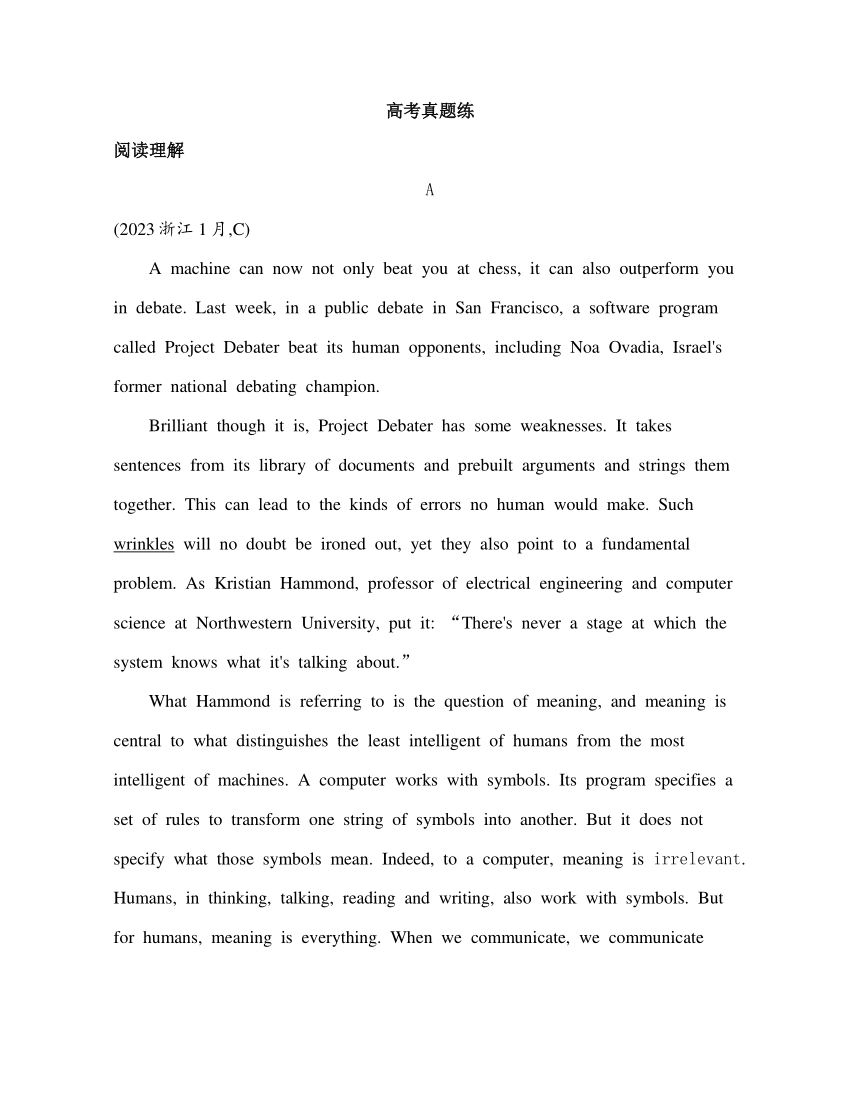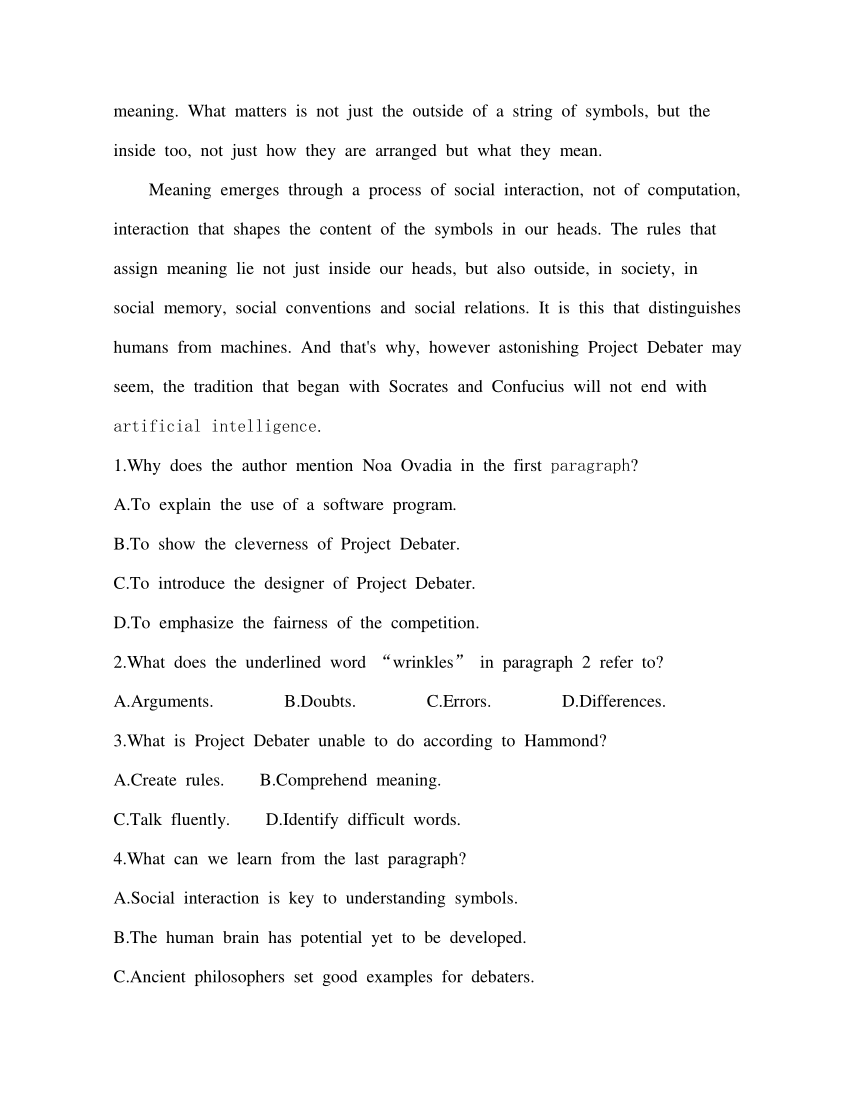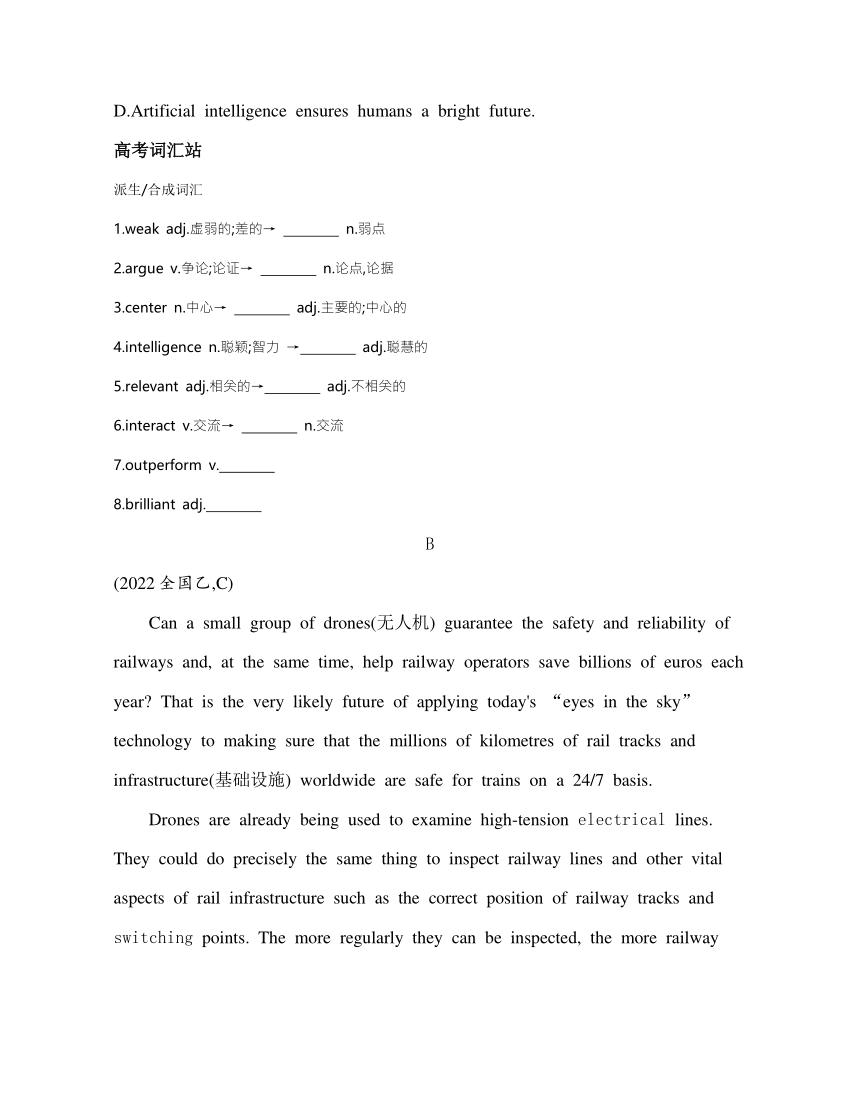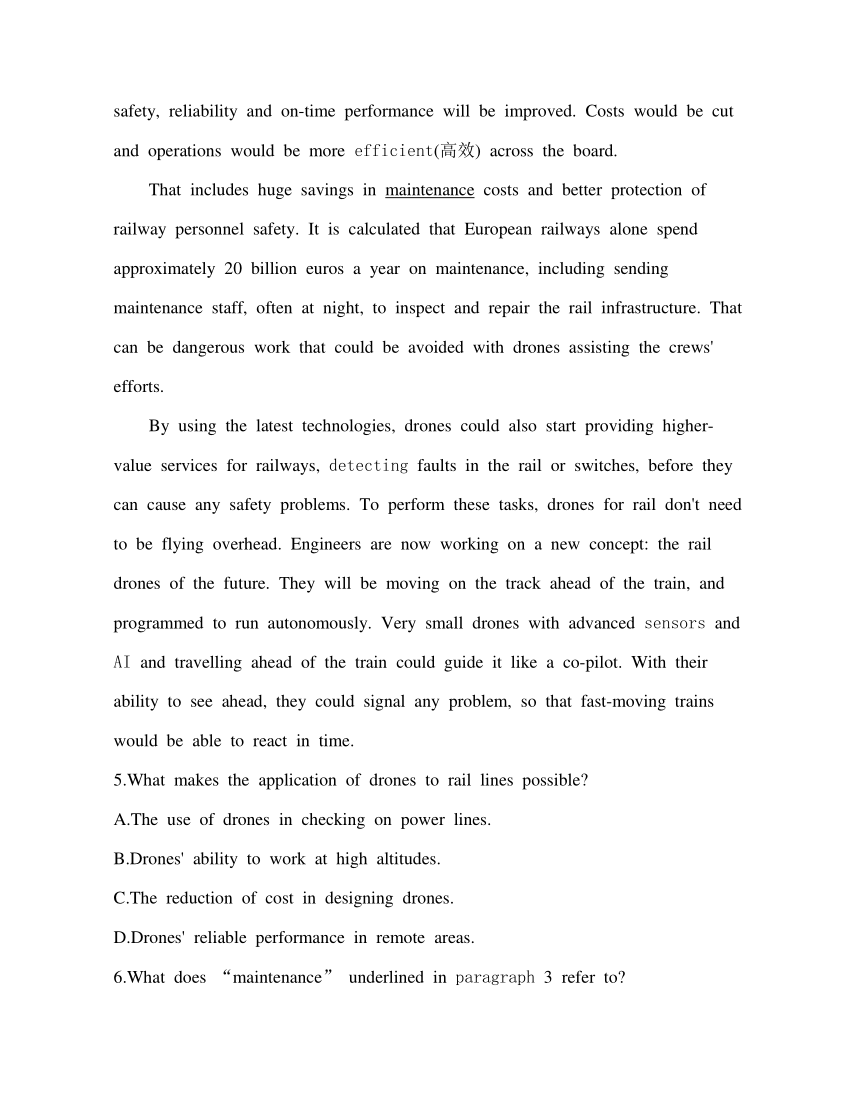UNIT 2 LOOKING INTO THE FUTURE高考真题练(含解析)
文档属性
| 名称 | UNIT 2 LOOKING INTO THE FUTURE高考真题练(含解析) |  | |
| 格式 | docx | ||
| 文件大小 | 30.7KB | ||
| 资源类型 | 试卷 | ||
| 版本资源 | 人教版(2019) | ||
| 科目 | 英语 | ||
| 更新时间 | 2025-10-20 08:47:14 | ||
图片预览




文档简介
高考真题练
阅读理解
A
(2023浙江1月,C)
A machine can now not only beat you at chess, it can also outperform you in debate. Last week, in a public debate in San Francisco, a software program called Project Debater beat its human opponents, including Noa Ovadia, Israel's former national debating champion.
Brilliant though it is, Project Debater has some weaknesses. It takes sentences from its library of documents and prebuilt arguments and strings them together. This can lead to the kinds of errors no human would make. Such wrinkles will no doubt be ironed out, yet they also point to a fundamental problem. As Kristian Hammond, professor of electrical engineering and computer science at Northwestern University, put it: “There's never a stage at which the system knows what it's talking about.”
What Hammond is referring to is the question of meaning, and meaning is central to what distinguishes the least intelligent of humans from the most intelligent of machines. A computer works with symbols. Its program specifies a set of rules to transform one string of symbols into another. But it does not specify what those symbols mean. Indeed, to a computer, meaning is irrelevant. Humans, in thinking, talking, reading and writing, also work with symbols. But for humans, meaning is everything. When we communicate, we communicate meaning. What matters is not just the outside of a string of symbols, but the inside too, not just how they are arranged but what they mean.
Meaning emerges through a process of social interaction, not of computation, interaction that shapes the content of the symbols in our heads. The rules that assign meaning lie not just inside our heads, but also outside, in society, in social memory, social conventions and social relations. It is this that distinguishes humans from machines. And that's why, however astonishing Project Debater may seem, the tradition that began with Socrates and Confucius will not end with artificial intelligence.
1.Why does the author mention Noa Ovadia in the first paragraph
A.To explain the use of a software program.
B.To show the cleverness of Project Debater.
C.To introduce the designer of Project Debater.
D.To emphasize the fairness of the competition.
2.What does the underlined word “wrinkles” in paragraph 2 refer to
A.Arguments. B.Doubts. C.Errors. D.Differences.
3.What is Project Debater unable to do according to Hammond
A.Create rules. B.Comprehend meaning.
C.Talk fluently. D.Identify difficult words.
4.What can we learn from the last paragraph
A.Social interaction is key to understanding symbols.
B.The human brain has potential yet to be developed.
C.Ancient philosophers set good examples for debaters.
D.Artificial intelligence ensures humans a bright future.
高考词汇站
派生/合成词汇
1.weak adj.虚弱的;差的→ n.弱点
2.argue v.争论;论证→ n.论点,论据
3.center n.中心→ adj.主要的;中心的
4.intelligence n.聪颖;智力 → adj.聪慧的
5.relevant adj.相关的→ adj.不相关的
6.interact v.交流→ n.交流
7.outperform v.
8.brilliant adj.
B
(2022全国乙,C)
Can a small group of drones(无人机) guarantee the safety and reliability of railways and, at the same time, help railway operators save billions of euros each year That is the very likely future of applying today's “eyes in the sky” technology to making sure that the millions of kilometres of rail tracks and infrastructure(基础设施) worldwide are safe for trains on a 24/7 basis.
Drones are already being used to examine high-tension electrical lines. They could do precisely the same thing to inspect railway lines and other vital aspects of rail infrastructure such as the correct position of railway tracks and switching points. The more regularly they can be inspected, the more railway safety, reliability and on-time performance will be improved. Costs would be cut and operations would be more efficient(高效) across the board.
That includes huge savings in maintenance costs and better protection of railway personnel safety. It is calculated that European railways alone spend approximately 20 billion euros a year on maintenance, including sending maintenance staff, often at night, to inspect and repair the rail infrastructure. That can be dangerous work that could be avoided with drones assisting the crews' efforts.
By using the latest technologies, drones could also start providing higher-value services for railways, detecting faults in the rail or switches, before they can cause any safety problems. To perform these tasks, drones for rail don't need to be flying overhead. Engineers are now working on a new concept: the rail drones of the future. They will be moving on the track ahead of the train, and programmed to run autonomously. Very small drones with advanced sensors and AI and travelling ahead of the train could guide it like a co-pilot. With their ability to see ahead, they could signal any problem, so that fast-moving trains would be able to react in time.
5.What makes the application of drones to rail lines possible
A.The use of drones in checking on power lines.
B.Drones' ability to work at high altitudes.
C.The reduction of cost in designing drones.
D.Drones' reliable performance in remote areas.
6.What does “maintenance” underlined in paragraph 3 refer to
A.Personnel safety.
B.Assistance from drones.
C.Inspection and repair.
D.Construction of infrastructure.
7.What function is expected of the rail drones
A.To provide early warning.
B.To make trains run automatically.
C.To earn profits for the crews.
D.To accelerate transportation.
8.Which is the most suitable title for the text
A.What Faults Can Be Detected with Drones
B.How Production of Drones Can Be Expanded
C.What Difficulty Drone Development Will Face
D.How Drones Will Change the Future of Railways
高考词汇站
派生/合成词汇
1.reliable adj.可靠的→ n.可靠性;可信度
2.operate v.操作;运转→ n.操作,运行→ n.操作员
3.safe adj.安全的→ n.安全,平安;安全性
4.protect v.保护→ n.保护
5.approximate adj.大约的;近似的→ adv.近似;大约
6.railway n.
7.high-tension adj.
8.overhead adv.
9.co-pilot n.
10.fast-moving adj.
答案与分层梯度式解析
高考真题练
A
◎语篇解读 本文是一篇说明文,主要通过介绍一个名为Project Debater的软件程序在辩论中战胜了人类对手,以及它明显的缺陷——无法理解意义,说明了社会交往才是理解意义的关键所在。
1.B 推理判断题。根据第一段第二句中的“ a software program called Project Debater beat its human opponents, including Noa Ovadia, Israel's former national debating champion”可知,一个名为Project Debater的软件程序击败了它的人类对手,其中包括以色列前全国辩论冠军Noa Ovadia。所以,作者在第一段提到Noa Ovadia的目的是展示Project Debater的聪明。故选B。
2.C 词义猜测题。画线处上文提到“尽管Project Debater很聪明,但它也有一些弱点。它从文档库和预先构建的论点中提取句子,并将它们串在一起。这可能会导致人类不会犯的错误”。画线处所在句子意思是“这样的 wrinkles无疑会被解决”,由此可知,画线词wrinkles的意思是“错误”,和errors意思相近,故选C。
3.B 细节理解题。倒数第二段提到Hammond所指的是意义的问题,而意义是区分最不聪明的人类和最聪明的机器的关键,计算机使用符号,它的程序指定了一组将一串符号转换为另一串符号的规则,但它并没有具体说明这些符号的含义,事实上,对于计算机来说,意义是无关紧要的。由此可知,根据Hammond的说法,Project Debater不能理解意义,故选B。
4.A 细节理解题。根据最后一段前三句提到“意义的产生是通过社会互动的过程,而不是计算的过程,这种互动塑造了我们头脑中符号的内容。赋予意义的规则不仅存在于我们的头脑中,也存在于我们的头脑之外,存在于社会记忆、社会习俗和社会关系中。这就是人类与机器的区别。”可知,从最后一段我们能了解到社会互动是理解符号的关键。故选A。
长难句
原句1 As Kristian Hammond, professor of electrical engineering and computer science at Northwestern University, put it: “There's never a stage at which the system knows what it's talking about.”
分析 该句是一个主从复合句。As引导非限制性定语从句,as sb. put it意为“正如某人所说”;at which引导限制性定语从句,修饰先行词stage;what引导宾语从句。
译文 正如西北大学电子工程和计算机科学教授Kristian Hammond所说的:“从来没有一个阶段系统知道它在说什么。”
原句2 What Hammond is referring to is the question of meaning, and meaning is central to what distinguishes the least intelligent of humans from the most intelligent of machines.
分析 该句是一个并列复合句。and连接前后两个并列的分句。在第一个分句中What引导主语从句,第二个分句中what引导介词to后的宾语从句。
译文 Hammond指的是意义的问题,而意义是区分最不聪明的人类和最聪明的机器的核心。
【高考词汇站】 1.weakness 2.argument 3.central
4.intelligent 5.irrelevant 6.interaction 7.做得比……好;胜过 8.聪颖的
B
◎语篇解读 本文介绍了一种铁路无人机,这种无人机可以保障铁路安全并能大量节省铁路维护费用。
5.A 细节理解题。由第二段第一、二句“Drones are already being used to examine high-tension electrical lines. They could do precisely the same thing to inspect railway lines and other vital aspects of rail infrastructure... (无人机已经被用来检查高压电线。它们完全可以做同样的事情来检查铁路线和铁路基础设施的其他重要方面……)”可知,无人机在检查高压电线方面的应用使它们在铁路线方面的应用成为可能。
6.C 词义猜测题。由第三段第二句尤其是其中的“sending maintenance staff”和“to inspect and repair the rail infrastructure”可知,派遣维修人员是为了检查和维修铁路基础设施,因此maintenance表示“检查和维修”。
7.A 细节理解题。由最后一段最后一句“With their ability to see ahead, they could signal any problem, so that fast-moving trains would be able to react in time.”可知,铁路无人机有望具备预警的功能。
8.D 主旨大意题。纵观全文,梳理文章结构:第一段通过设问引出话题:无人机在铁路领域的应用;第二段分析将无人机运用于该领域的可行性;第三、四段介绍应用后的好处。由此可知,文章主要说明无人机会如何改变铁路的未来,故以此为题目最合适。
【高考词汇站】 1.reliability 2.operation;operator
3.safety 4.protection 5.approximately 6.铁路 7.高压的 8.在空中,在头上方 9.(飞机的)副驾驶员 10.迅速移动的
阅读理解
A
(2023浙江1月,C)
A machine can now not only beat you at chess, it can also outperform you in debate. Last week, in a public debate in San Francisco, a software program called Project Debater beat its human opponents, including Noa Ovadia, Israel's former national debating champion.
Brilliant though it is, Project Debater has some weaknesses. It takes sentences from its library of documents and prebuilt arguments and strings them together. This can lead to the kinds of errors no human would make. Such wrinkles will no doubt be ironed out, yet they also point to a fundamental problem. As Kristian Hammond, professor of electrical engineering and computer science at Northwestern University, put it: “There's never a stage at which the system knows what it's talking about.”
What Hammond is referring to is the question of meaning, and meaning is central to what distinguishes the least intelligent of humans from the most intelligent of machines. A computer works with symbols. Its program specifies a set of rules to transform one string of symbols into another. But it does not specify what those symbols mean. Indeed, to a computer, meaning is irrelevant. Humans, in thinking, talking, reading and writing, also work with symbols. But for humans, meaning is everything. When we communicate, we communicate meaning. What matters is not just the outside of a string of symbols, but the inside too, not just how they are arranged but what they mean.
Meaning emerges through a process of social interaction, not of computation, interaction that shapes the content of the symbols in our heads. The rules that assign meaning lie not just inside our heads, but also outside, in society, in social memory, social conventions and social relations. It is this that distinguishes humans from machines. And that's why, however astonishing Project Debater may seem, the tradition that began with Socrates and Confucius will not end with artificial intelligence.
1.Why does the author mention Noa Ovadia in the first paragraph
A.To explain the use of a software program.
B.To show the cleverness of Project Debater.
C.To introduce the designer of Project Debater.
D.To emphasize the fairness of the competition.
2.What does the underlined word “wrinkles” in paragraph 2 refer to
A.Arguments. B.Doubts. C.Errors. D.Differences.
3.What is Project Debater unable to do according to Hammond
A.Create rules. B.Comprehend meaning.
C.Talk fluently. D.Identify difficult words.
4.What can we learn from the last paragraph
A.Social interaction is key to understanding symbols.
B.The human brain has potential yet to be developed.
C.Ancient philosophers set good examples for debaters.
D.Artificial intelligence ensures humans a bright future.
高考词汇站
派生/合成词汇
1.weak adj.虚弱的;差的→ n.弱点
2.argue v.争论;论证→ n.论点,论据
3.center n.中心→ adj.主要的;中心的
4.intelligence n.聪颖;智力 → adj.聪慧的
5.relevant adj.相关的→ adj.不相关的
6.interact v.交流→ n.交流
7.outperform v.
8.brilliant adj.
B
(2022全国乙,C)
Can a small group of drones(无人机) guarantee the safety and reliability of railways and, at the same time, help railway operators save billions of euros each year That is the very likely future of applying today's “eyes in the sky” technology to making sure that the millions of kilometres of rail tracks and infrastructure(基础设施) worldwide are safe for trains on a 24/7 basis.
Drones are already being used to examine high-tension electrical lines. They could do precisely the same thing to inspect railway lines and other vital aspects of rail infrastructure such as the correct position of railway tracks and switching points. The more regularly they can be inspected, the more railway safety, reliability and on-time performance will be improved. Costs would be cut and operations would be more efficient(高效) across the board.
That includes huge savings in maintenance costs and better protection of railway personnel safety. It is calculated that European railways alone spend approximately 20 billion euros a year on maintenance, including sending maintenance staff, often at night, to inspect and repair the rail infrastructure. That can be dangerous work that could be avoided with drones assisting the crews' efforts.
By using the latest technologies, drones could also start providing higher-value services for railways, detecting faults in the rail or switches, before they can cause any safety problems. To perform these tasks, drones for rail don't need to be flying overhead. Engineers are now working on a new concept: the rail drones of the future. They will be moving on the track ahead of the train, and programmed to run autonomously. Very small drones with advanced sensors and AI and travelling ahead of the train could guide it like a co-pilot. With their ability to see ahead, they could signal any problem, so that fast-moving trains would be able to react in time.
5.What makes the application of drones to rail lines possible
A.The use of drones in checking on power lines.
B.Drones' ability to work at high altitudes.
C.The reduction of cost in designing drones.
D.Drones' reliable performance in remote areas.
6.What does “maintenance” underlined in paragraph 3 refer to
A.Personnel safety.
B.Assistance from drones.
C.Inspection and repair.
D.Construction of infrastructure.
7.What function is expected of the rail drones
A.To provide early warning.
B.To make trains run automatically.
C.To earn profits for the crews.
D.To accelerate transportation.
8.Which is the most suitable title for the text
A.What Faults Can Be Detected with Drones
B.How Production of Drones Can Be Expanded
C.What Difficulty Drone Development Will Face
D.How Drones Will Change the Future of Railways
高考词汇站
派生/合成词汇
1.reliable adj.可靠的→ n.可靠性;可信度
2.operate v.操作;运转→ n.操作,运行→ n.操作员
3.safe adj.安全的→ n.安全,平安;安全性
4.protect v.保护→ n.保护
5.approximate adj.大约的;近似的→ adv.近似;大约
6.railway n.
7.high-tension adj.
8.overhead adv.
9.co-pilot n.
10.fast-moving adj.
答案与分层梯度式解析
高考真题练
A
◎语篇解读 本文是一篇说明文,主要通过介绍一个名为Project Debater的软件程序在辩论中战胜了人类对手,以及它明显的缺陷——无法理解意义,说明了社会交往才是理解意义的关键所在。
1.B 推理判断题。根据第一段第二句中的“ a software program called Project Debater beat its human opponents, including Noa Ovadia, Israel's former national debating champion”可知,一个名为Project Debater的软件程序击败了它的人类对手,其中包括以色列前全国辩论冠军Noa Ovadia。所以,作者在第一段提到Noa Ovadia的目的是展示Project Debater的聪明。故选B。
2.C 词义猜测题。画线处上文提到“尽管Project Debater很聪明,但它也有一些弱点。它从文档库和预先构建的论点中提取句子,并将它们串在一起。这可能会导致人类不会犯的错误”。画线处所在句子意思是“这样的 wrinkles无疑会被解决”,由此可知,画线词wrinkles的意思是“错误”,和errors意思相近,故选C。
3.B 细节理解题。倒数第二段提到Hammond所指的是意义的问题,而意义是区分最不聪明的人类和最聪明的机器的关键,计算机使用符号,它的程序指定了一组将一串符号转换为另一串符号的规则,但它并没有具体说明这些符号的含义,事实上,对于计算机来说,意义是无关紧要的。由此可知,根据Hammond的说法,Project Debater不能理解意义,故选B。
4.A 细节理解题。根据最后一段前三句提到“意义的产生是通过社会互动的过程,而不是计算的过程,这种互动塑造了我们头脑中符号的内容。赋予意义的规则不仅存在于我们的头脑中,也存在于我们的头脑之外,存在于社会记忆、社会习俗和社会关系中。这就是人类与机器的区别。”可知,从最后一段我们能了解到社会互动是理解符号的关键。故选A。
长难句
原句1 As Kristian Hammond, professor of electrical engineering and computer science at Northwestern University, put it: “There's never a stage at which the system knows what it's talking about.”
分析 该句是一个主从复合句。As引导非限制性定语从句,as sb. put it意为“正如某人所说”;at which引导限制性定语从句,修饰先行词stage;what引导宾语从句。
译文 正如西北大学电子工程和计算机科学教授Kristian Hammond所说的:“从来没有一个阶段系统知道它在说什么。”
原句2 What Hammond is referring to is the question of meaning, and meaning is central to what distinguishes the least intelligent of humans from the most intelligent of machines.
分析 该句是一个并列复合句。and连接前后两个并列的分句。在第一个分句中What引导主语从句,第二个分句中what引导介词to后的宾语从句。
译文 Hammond指的是意义的问题,而意义是区分最不聪明的人类和最聪明的机器的核心。
【高考词汇站】 1.weakness 2.argument 3.central
4.intelligent 5.irrelevant 6.interaction 7.做得比……好;胜过 8.聪颖的
B
◎语篇解读 本文介绍了一种铁路无人机,这种无人机可以保障铁路安全并能大量节省铁路维护费用。
5.A 细节理解题。由第二段第一、二句“Drones are already being used to examine high-tension electrical lines. They could do precisely the same thing to inspect railway lines and other vital aspects of rail infrastructure... (无人机已经被用来检查高压电线。它们完全可以做同样的事情来检查铁路线和铁路基础设施的其他重要方面……)”可知,无人机在检查高压电线方面的应用使它们在铁路线方面的应用成为可能。
6.C 词义猜测题。由第三段第二句尤其是其中的“sending maintenance staff”和“to inspect and repair the rail infrastructure”可知,派遣维修人员是为了检查和维修铁路基础设施,因此maintenance表示“检查和维修”。
7.A 细节理解题。由最后一段最后一句“With their ability to see ahead, they could signal any problem, so that fast-moving trains would be able to react in time.”可知,铁路无人机有望具备预警的功能。
8.D 主旨大意题。纵观全文,梳理文章结构:第一段通过设问引出话题:无人机在铁路领域的应用;第二段分析将无人机运用于该领域的可行性;第三、四段介绍应用后的好处。由此可知,文章主要说明无人机会如何改变铁路的未来,故以此为题目最合适。
【高考词汇站】 1.reliability 2.operation;operator
3.safety 4.protection 5.approximately 6.铁路 7.高压的 8.在空中,在头上方 9.(飞机的)副驾驶员 10.迅速移动的
